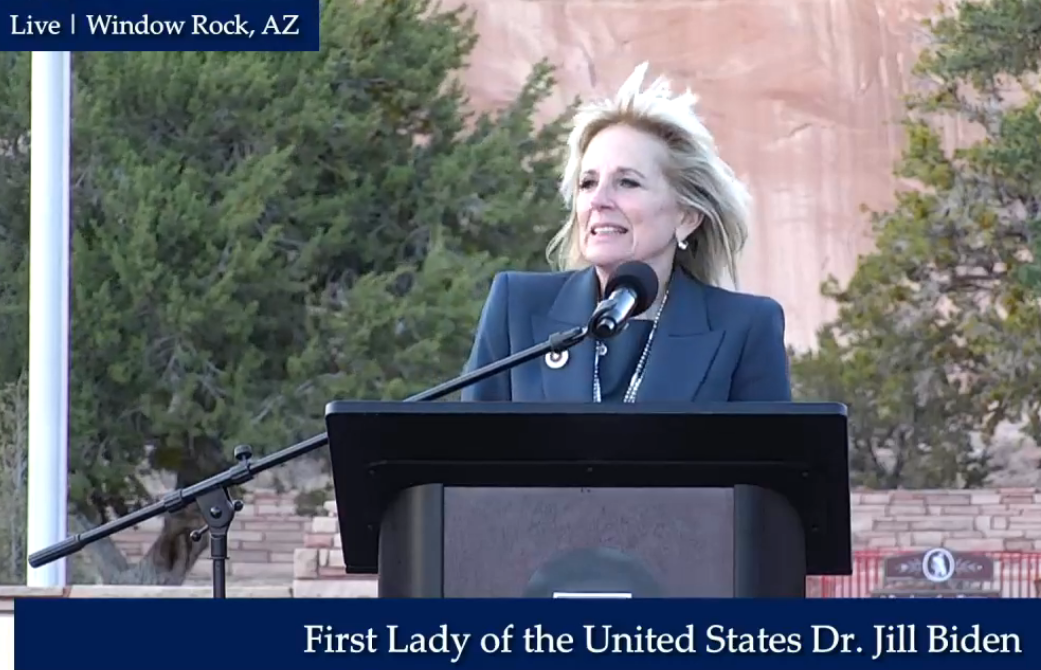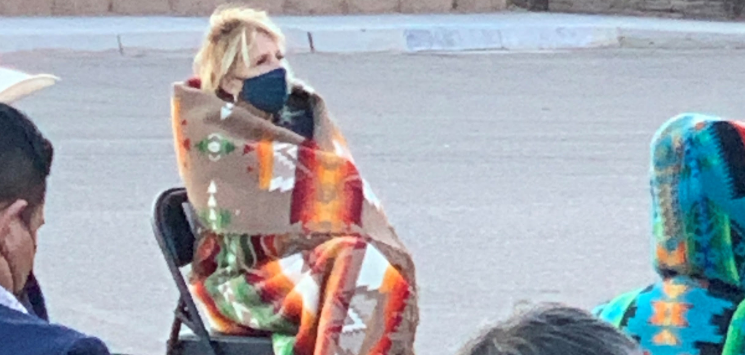
- Details
- By Native News Online Staff
WINDOW ROCK, Ariz. — Navajo Nation leaders welcomed the First Lady Jill Biden to the capital of the Navajo Nation on Thursday. A welcome ceremony was held at Navajo Veterans Memorial Park in Window Rock, Ariz. On hand to welcome. Biden to the country’s largest Indian reservation were Navajo Nation President Jonathan Nez, First Lady Phefelia Nez, Vice President Myron Lizer, Second Lady Dottie Lizer, along with members of the 24th Navajo Nation Council and Navajo Nation Chief Justice JoAnn B. Jayne.
First Lady Biden addressed the Navajo people and leaders, which was aired live on the Nez-Lizer Facebook page and local radio stations. In her public address, First Lady Biden stated that the Biden-Harris Administration will always stand beside and work with American Indian tribes, including the Navajo Nation.
“Honoring the treaty trust obligations and responsibilities between tribes and the federal government will be recognized. With beauty, harmony, and Hozhó in front of us, behind us, above us, below us, and around us, we can build and strengthen Mother Earth and our Nation. We stand with the Navajo Nation today, tomorrow, and always,” First Lady Biden said.

“I met with President Biden and Vice President Harris last October, at that time, nominee Biden promised to listen to Native American people and understood the importance of the government-to-government relationship and in November the Navajo people came out and delivered the State of Arizona on election day, even in the midst of this terrible pandemic. We are very pleased that the Biden-Harris Administration is keeping their promise by having a seat at the table for the Navajo Nation and other tribes,” President Nez said.
He also praised health care workers and first responders who continue to sacrifice time with their families and put themselves at risk to treat COVID-19 patients and to save lives by administering the vaccines. President Nez noted that well over half of the adult population residing on the Navajo Nation have been fully vaccinated.
Prior to the public welcome event, First Lady Biden joined Navajo Nation First Lady Phefelia Nez and Second Lady Dottie Lizer for a discussion with several women leaders, educators, business owners, organizers, and advocates including 24th Navajo Nation Council Delegate Amber Kanazbah Crotty who chairs the Sexual Assault Prevention Subcommittee, Arviso Construction project manager Brianne Arviso, Tséhootsooí Medical Center respiratory therapist and cancer survivor Sarah Dahozy, Navajo Technical University Board of Regents member Gloria Grant, Navajo Nation Board of Education President Priscilla Manuelito, Navajo artisan and wellness advocate Gwendolyn Sandra McCray, Navajo United Way Executive Director Dr. Laura Mike, and First Things First Navajo Regional Director Memarie Tsosie.
The roundtable participants also presented recommendations to provide more support for Navajo families and individuals and service programs and organizations. The discussion also highlighted underfunded and under-resourced programs and initiatives that hinder effective and adequate services to Navajo families and individuals.
Council Delegate Amber Kanazbah Crotty discussed the Missing and Murdered Diné Relatives (MMDR) epidemic. According to a recent MMDR and the Sovereign Bodies Institute report, 164 missing Navajo persons have been documented from 1951 to 2019. Of these cases, it is reported that 38 percent are missing persons cases, and 62 percent are murder cases. Additionally, 41 percent of these cases occurred on the Navajo Nation, 10 percent occurred off the Navajo Nation, and 49 percent of these cases occurred in urban communities. The goal is to raise awareness, to support families recover their relatives and increase the capacity of law enforcement to respond, she added.
On Friday, First Lady Biden will visit a local school and vaccine site to speak with students, educators, and health care workers. The Navajo Nation Office of the President and Vice President is working with the White House to provide live-streaming of several of the events on the Nez-Lizer Facebook page: https://www.facebook.com/NezLizer2018.
More Stories Like This
Native News Weekly (August 25, 2024): D.C. BriefsUS Presidents in Their Own Words Concerning American Indians
Monday Morning (December 8, 2025): Articles You May Have Missed This Past Weekend
Native News Weekly (December 7, 2025): D.C. Briefs
Breaking: Final Defense Legislation Grants Federal Recognition to Lumbee Tribe
Help us defend tribal sovereignty.
At Native News Online, our mission is rooted in telling the stories that strengthen sovereignty and uplift Indigenous voices — not just at year’s end, but every single day.
Because of your generosity last year, we were able to keep our reporters on the ground in tribal communities, at national gatherings and in the halls of Congress — covering the issues that matter most to Indian Country: sovereignty, culture, education, health and economic opportunity.
That support sustained us through a tough year in 2025. Now, as we look to the year ahead, we need your help right now to ensure warrior journalism remains strong — reporting that defends tribal sovereignty, amplifies Native truth, and holds power accountable.
 The stakes couldn't be higher. Your support keeps Native voices heard, Native stories told and Native sovereignty defended.
The stakes couldn't be higher. Your support keeps Native voices heard, Native stories told and Native sovereignty defended.
Stand with Warrior Journalism today.
Levi Rickert (Potawatomi), Editor & Publisher

